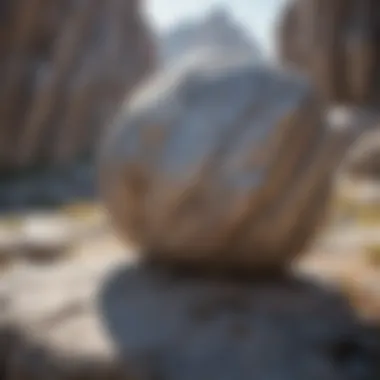Exploring the Intricacies of Granite Stone


Intro
Granite stone stands out as a significant component of the Earth's crust and a key material in various industries. Its formation, originating from the slow crystallization of magma beneath the surface, gives it unique characteristics that are both beneficial and aesthetically pleasing. Understanding the nature of granite involves exploring its composition, geological origin, and the many ways it has been utilized across time.
Granite's particular blend of minerals, primarily quartz, feldspar, and mica, contributes to its strength and durability. These properties make it a favored choice for structures ranging from ancient buildings to modern countertops. This article aims to dissect these elements in depth, offering a thorough exploration of granite stone.
Featured Collectible of the Month
Overview
As the market for natural stones grows, certain specimens of granite gain recognition not only for their utility but also for their beauty. One such collectible is the Blue Bahía Granite, renowned for its vivid blue and gray hues that capture the attention of collectors and designers alike.
Historical Significance
Granite has a long history that intertwines with human civilization. For centuries, cultures have utilized granite in monolithic structures, a testament to its lasting qualities. The Pyramids of Giza, for instance, feature granite components that have endured millennia. This material is not only an architectural choice but also a symbol of power and permanence.
"Granite's historical significance showcases the connection between people and the earth, rooted in both practical and aesthetic values."
Identification Techniques
Visual Characteristics
Identifying granite is essential for collectors. Granite typically exhibits a coarse-grained texture due to its crystalline structure. Observers should look for the following visual traits:
- Color Variance: Ranges from light grays to deep reds and blacks.
- Mineral Distribution: Noticeable speckles of quartz and feldspar.
- Luster: A slight sheen often resulting from the mineral content.
Resources for Identification
For those involved in the collection, verifying granite types can be important. Here are some useful resources to aid in identification:
By understanding the foundational elements of granite, collectors can develop a deeper connection to this remarkable stone, appreciating its history, uniqueness, and significance in both geology and architecture.
Understanding Granite Stone
Granite stone is an essential subject within geology, as it embodies significant characteristics that impact both natural landscapes and human applications. Understanding granite involves examining its properties, formations, and varieties. Knowledge of granite is not solely of academic interest; it influences industries such as construction, architecture, and interior design. Proper understanding can lead to informed choices in selecting granite for various purposes, hence its importance cannot be overstated.
Definition and Characteristics
Granite is a coarse-grained igneous rock composed predominantly of quartz, feldspar, and mica. Its formation involved the slow crystallization of molten rock beneath the Earth’s surface. This process leads to the distinct grains visible in granite, which are a hallmark of its appearance. One of the defining characteristics of granite is its durability. It exhibits excellent resistance to abrasion, weathering, and heat, contributing to its popularity in both natural settings and human-made structures.
Granite is also valued for its aesthetic appeal. The various mineral compositions lend a spectrum of colors and patterns that can enhance visual appeal in architectural applications. These characteristics make granite a suitable material for a range of uses, from countertops to monumental sculptures.
Types of Granite
Granite varies greatly and can be classified into specific types based on mineral composition and visual characteristics.
Porphyritic Granite
Porphyritic granite features large crystals embedded in a finer-grained background. This unique texture forms during a two-phase cooling process. Large crystals form first when molten rock cools slowly at great depths. Afterward, the remaining molten material cools more rapidly, creating smaller crystals. This variation provides a striking contrast that is visually appealing.
Porphyritic granite’s durability makes it a popular choice for high-traffic areas and construction projects. However, its unique appearance can sometimes result in higher costs than standard granite. Its visual characteristics can be beneficial in design, allowing it to stand out in a variety of settings.
Biotite Granite
Biotite granite contains biotite mica, which gives it a dark, speckled appearance. This granite type is often found in areas rich in volcanic activity. The key characteristic of biotite granite is its dark mineral content, which contributes to its distinct look.
This variety of granite is considered beneficial due to its strength and durability, making it suitable for exterior structures. However, the darker color can absorb more heat, which may be a disadvantage in certain climates. Despite this, biotite granite remains a popular choice for both functional and aesthetic applications.
Muscovite Granite
Muscovite granite is characterized by the presence of muscovite mica, which contributes a lighter color and gives it a shiny appearance. This granite type often exhibits a lighter hue, ranging from white to pinkish tones, which can be appealing in many installations.


The aesthetic appeal of muscovite granite makes it a desirable choice for interior applications like countertops and flooring. However, the presence of muscovite can also make it more prone to weathering compared to other granite types. Despite this vulnerability, its beauty and elegance continue to secure its place within various designs and constructions.
"Understanding the different types of granite enhances not only our knowledge of geology but also informs decision-making in construction and design."
Geological Formation
The geological formation of granite is crucial to understanding the stone's characteristics and its role in various industries. Granite is an igneous rock that forms from the slow crystallization of magma below the Earth's surface. This section explores how granite is born from geological processes, emphasizing its primary causes and the role of magma in its formation.
Igneous Rock Formation
Igneous rock formation is the beginning of granite's life as a stone. Understanding this process allows us to appreciate granite's unique features and the intricate systems that lead to its development.
Primary Causes of Formation
Granite primarily forms due to high-temperature melting of rocks beneath the Earth's crust. This melting occurs mainly in subduction zones, where tectonic plates collide. The pressure and heat transform existing rocks into magma, which then contributes to granite's creation.
The key characteristic of this process is the ability of the magma to rise slowly through the crust. This rising allows for the gradual cooling and solidification of the magma, leading to a coarse-grained texture often found in granite. This aspect is significant because it contributes to the strength and durability that granite is known for. Slow cooling rates give the minerals time to crystallize properly, resulting in the distinct appearance of granite, with its visible mineral grains.
The unique feature of this formation process is the diverse mineral composition that results. This characteristic can be beneficial as it allows for a variety of granite types such as Biotite and Muscovite granite, each with unique appearances and properties. However, if the cooling is too rapid, flaws can occur in the structure, resulting in inferior quality stone.
Cooling Processes
Cooling processes are vital to granite formation, involving how magma solidifies after rising. In larger bodies of magma, called intrusions, granite forms as the surrounding rock insulates the magma. This slow cooling leads to the formation of large crystals, defining granite's signature look.
The key characteristic of these cooling processes is the rate at which temperature decreases. When magma cools slowly, typically over thousands of years, it allows crystals such as feldspar and quartz to develop fully. This slow solidification results in the well-defined crystalline structure that makes granite a preferred material for many applications.
One unique feature in the cooling process is the formation of pockets of gas and water vapor within the magma. These pockets can create vesicular textures in some granite types, adding complexity to their aesthetic. However, uneven cooling can lead to weaknesses and fissures, which can be a disadvantage in practical applications.
The Role of Magma
Magma is at the heart of the granite formation process. Its composition and behavior play a significant role in determining the final characteristics of the granite.
Composition of Magma
The composition of magma is critical since it dictates which minerals will crystallize as the magma cools. It typically consists of silicates, especially feldspar and quartz, alongside other minerals. This composition influences the specific granite type formed and its physical attributes.
The key characteristic of magma composition is its varied mineral content. Different types of granite arise based on the ratio and presence of these minerals, leading to a rich diversity of appearances and functions. For example, high quartz content leads to a lighter-colored granite, while higher feldspar levels typically yield darker tones.
A unique feature of magma is its ability to interact with surrounding rocks. This interaction can lead to contamination or alteration, resulting in granite with unique mineral combinations. However, this can also be a disadvantage, as excessive contamination can weaken the rock structure, making it less desirable for certain uses.
Crystal Growth
Crystal growth is a key aspect of granite that occurs when magma cools. The slower the cooling rate, the larger the crystals grow, significantly affecting the granite's texture and appearance. Larger crystals are more visually distinct and contribute to the overall aesthetic quality of the stone.
The primary characteristic of crystal growth is the interlocking nature of these minerals, which adds to granite's stability and strength. This quality is essential for construction purposes, where durability is a primary concern.
The unique feature of crystal growth is that it also allows for the development of different colors and patterns. Variations in mineral concentrations can create stunning visuals, making granite a popular choice in architecture and design. However, uneven growth can lead to blemishes, which might detract from its natural beauty in some applications.
Granite's geological formation reveals a complex interplay of heat, pressure, and time, resulting in one of nature's most durable and beautiful stones.
In summary, the geological formation of granite involves intricate processes that define its properties and applications. By understanding these elements, one can appreciate the stone fully and its crucial role in both geologic and architectural contexts.
Physical and Chemical Properties
Understanding the physical and chemical properties of granite stone is crucial for various applications. These characteristics influence its suitability for construction, design, and its geological significance. Granite's durability and resistance to environmental factors make it a material of choice in multiple domains. By examining its mineral composition and specific properties, one can grasp the reasons behind granite's enduring popularity.
Mineral Composition
Feldspar
Feldspar is a key component of granite, constituting about 60% of its composition. It is a group of minerals that play a significant role in the overall structure. One of the most noted characteristics of feldspar is its high durability. This characteristic makes it a beneficial choice in granite because it enhances the stone's strength. Furthermore, the presence of feldspar contributes to granite's color variations, providing aesthetic versatility. A unique feature of feldspar is its capacity to undergo weathering processes, which leads to the formation of clay minerals. However, while feldspar adds to the stone's appeal, it can also be susceptible to chemical weathering over time.
Quartz


Quartz is also abundant in granite, accounting for approximately 30% of its volume. Known for its exceptional hardness, quartz contributes significantly to the stone's strength and resilience. This property makes quartz a popular choice for durable surfaces like countertops and flooring. Moreover, the specific crystalline structure of quartz helps resist cracking. Its unique feature is its ability to remain stable under heat and pressure. However, despite its toughness, quartz can be challenging to source in certain areas, potentially increasing costs in granite production and transportation.
Mica
Mica, present in smaller percentages, adds unique qualities to granite. This mineral is known for its distinct sheet-like structure, which provides flexibility. Mica enhances the overall appearance of granite by adding a subtle shine. This characteristic makes it a beneficial addition to the stone, particularly for decorative applications. Another exceptional feature of mica is its resistance to heat, making it suitable for kitchen countertops. However, mica’s relative softness compared to other minerals in granite can make it prone to scratching.
Durability and Strength
Durability and strength are defining attributes of granite stone, playing a significant role in its applicability across industries.
Hardness Scale
The hardness scale, known as the Mohs scale, ranks minerals based on their hardness from one to ten. Granite typically scores between six and seven, marking it as a very hard material. This ranking is essential for understanding the practicality of granite in various applications. Its hardness makes it a beneficial choice for high-traffic areas and surfaces that undergo frequent use. A unique feature of the hardness of granite is its ability to resist scratches and abrasions, enhancing its longevity. However, the high hardness can also make granite more challenging to work with during installation and fabrication processes.
Weathering Resistance
One of the major strengths of granite is its weathering resistance. This property allows granite to withstand environmental stressors like wind and rain, maintaining its structural integrity over time. Its ability to resist chemical weathering, especially from acidic substances, is particularly significant for outdoor applications. The unique feature of granite's weathering resistance is its low porosity, which minimizes water absorption and prevents damage from freeze-thaw cycles. Nonetheless, while granite is highly durable, it is not entirely impervious to weathering over prolonged exposure in harsh conditions, requiring occasional maintenance.
Granite is not only a geological wonder but also serves essential roles in engineering and aesthetics across times.
Granite in Architecture
Granite plays a critical role in architecture, serving both aesthetic and functional purposes. Its natural strength and timeless beauty make it a preferred material for various applications. This section will explore the historical significance of granite in ancient monuments and modern uses, as well as the contemporary applications in kitchen countertops and architectural facades. Understanding these elements helps to appreciate granite not only as a rock but as an essential material in designing lasting structures.
Historical Significance
Ancient Monuments
Granite has been a foundational stone in the construction of many ancient monuments. The Great Pyramids of Giza and the temples of ancient Egypt are prime examples, showcasing granite's durability. The choice of granite in these monumental structures is largely due to its resistance to weathering, allowing these structures to withstand the test of time.
Granite's unique feature is its ability to be polished to a high sheen, which enhances its beauty. In ancient Egypt, this characteristic was crucial as it served not only structural integrity but also aesthetic appeal, reflecting light beautifully. The longevity of these monuments speaks to granite's strengths, making it a beneficial choice for lasting architectural impact. However, its weight can be a disadvantage during construction, often requiring advanced techniques and equipment to handle.
Modern Uses
In the modern era, granite continues to be celebrated for its versatility and durability. From government buildings to private homes, granite is used extensively in both functional and decorative capacities. Its ability to withstand a range of environmental conditions makes it an ideal building material.
One significant aspect of modern uses of granite is its incorporation into urban design. City squares, memorials, and public facilities often feature granite due to its resilience and ability to convey a sense of permanence and strength. Moreover, granite's variety of colors and patterns provides designers with numerous options for creativity. The unique feature here lies in its adaptability; however, the high cost can sometimes limit its use in more budget-conscious projects.
Contemporary Applications
Countertops
Granite is widely favored for kitchen countertops, combining beauty with practicality. Its resistance to scratching and staining makes it an excellent choice for food preparation areas. Additionally, granite can be sanitized effectively, ensuring hygiene in kitchens.
The key characteristic of granite countertops is their aesthetic appeal. They come in numerous colors and patterns, enabling homeowners to choose a design that complements their interior. The unique feature of these countertops is the customizability in size and finish. However, granite is porous, which means it requires sealing to prevent staining, adding maintenance considerations in comparison to synthetic materials.
Architectural Facades
Granite also finds extensive application in architectural facades. These facades not only provide an exterior aesthetic but also protect buildings from the elements. Granite's natural resistance to moisture and temperatures ensures longevity and stability for structure.
The essential aspect of granite facades is their sophisticated appearance, which lends buildings a sense of prestige and stability. Its unique feature is the range of finishes available, from rough textures to smooth surfaces. While granite facades are beneficial in terms of durability and maintenance, their significant weight can be a limitation in certain architectural designs. Additionally, the installation process can be more complex, requiring skilled labor to ensure proper support and alignment.
The enduring nature of granite makes it not only a resource for construction but also a symbol of strength and beauty in architecture.
Environmental Impact and Sustainability
Environmental impact and sustainability are crucial elements when discussing granite stone. As a widely used material, granite extraction and processing can bring about significant ecological consequences. Understanding these aspects not only informs best practices in the industry but also promotes a more responsible approach to resource management. Increased awareness of environmental issues related to granite encourages the adoption of sustainable practices, ultimately benefitting both businesses and the planet.
Mining Practices
Mining granite often involves quarrying, which can be detrimental to the surrounding environment. The process typically requires extensive land clearing, resulting in habitat destruction and loss of biodiversity. Furthermore, dust and noise generated during extraction can affect local communities and wildlife. Water usage during mining operations can lead to depletion of local water sources, impacting agriculture and drinking water supplies.
To mitigate these effects, companies are increasingly focusing on environmentally-friendly mining techniques. Methods like selective cutting and water recycling can help reduce waste and lower the ecological footprint of granite extraction.
Sustainable Sourcing


Sustainable sourcing of granite is an important aspect of minimizing environmental impact. It focuses on responsible practices in the supply chain, from extraction to delivery. By sourcing granite from quarries that implement sustainable practices, buyers can ensure their material selection aligns with environmental standards.
Recycling Granite
Recycling granite is a growing trend in the industry. This process involves repurposing granite waste from quarrying and fabrication rather than discarding it. The key characteristic of recycling granite is its ability to reduce waste and conserve natural resources. Using recycled granite can be a beneficial choice, as it typically maintains the aesthetic qualities and durability found in natural stone. One unique feature of recycled granite is its versatility—fabricators can use it in various applications, such as landscaping and architectural elements. However, a disadvantage might include the limited availability depending on local recycling facilities.
Ethical Considerations
Ethical considerations in sourcing granite focus on labor practices and community impacts. Ensuring that miners and factory workers are treated fairly is essential in promoting social responsibility. A key characteristic of addressing ethical considerations in the granite industry is transparency. Buyers increasingly expect detailed information about where materials come from and the conditions under which they were sourced. One unique feature of enhancing ethical sourcing is the potential for better community relations, as responsibly sourced granite can support local economies. However, ensuring compliance in distant mines can be challenging, which may lead to potential trust issues among consumers.
Economic Value
The economic value of granite stone extends far beyond its beauty and durability. This section aims to outline the various factors that contribute to its significance in both local and global markets. Granite's resilience lends itself to numerous applications, resulting in a robust demand within construction and decorative sectors.
Market Demand
Granite stone continues to capture attention in various industries, particularly in architecture and construction. The market demand arises from its strength, aesthetic appeal, and versatility. Demand is often driven by trends in building materials and consumer preferences for natural stones. Additionally, granite's ability to withstand wear and weathering makes it an appealing choice for long-lasting projects.
Key elements influencing market demand include:
- Residential Construction: Homeowners increasingly favor granite for kitchen countertops, flooring, and decorative elements.
- Commercial Projects: Builders choose granite for its durability in high-traffic areas, such as malls, offices, and hotels.
- Cultural Significance: Granite is often used in monuments and memorials, adding to its historical and cultural relevance.
As such, the market is expected to remain steady, and even grow, amid advancements in mining and processing techniques.
Future Trends
Economic trends related to granite are evolving, driven by innovations and shifts in application. Understanding these trends is crucial for stakeholders in the granite industry.
Technological Innovations
One of the key aspects shaping the future of granite is the technological innovations in extraction and processing. Automation and advanced machinery enhance productivity in mining operations. This efficiency not only reduces costs but also increases safety for workers in quarries.
Key characteristics of technological innovations include:
- Enhanced efficiency in cutting and shaping granite.
- Improved waste management through precision cutting techniques.
However, the investment in new machinery can pose financial challenges initially. Yet, these challenges are often outweighed by the long-term benefits of increased output and quality.
New Applications
The exploration of new applications for granite opens further avenues for economic growth. Innovative uses of granite in both traditional and modern contexts reflect a growing interest in sustainable and environmentally friendly practices.
Examples of new applications include:
- Interior Design Trends: Utilizing granite in various design elements, from furniture to decorative pieces.
- Green Building Projects: The use of granite in eco-friendly construction as a natural alternative to synthetic materials.
The increasing focus on sustainability offers advantages like a reduced environmental footprint. However, stakeholders should be cautious of the potential for market saturation, which could affect profitability.
"The value of granite is not just about its physical properties; it's about how we employ this ancient stone in our modern world."
Culmination
The conclusion of this article serves as a vital synthesis of the discussions surrounding granite stone. Understanding granite is not merely an academic pursuit; it has practical implications across various fields such as geology, architecture, and environmental sustainability. Granite, being a resilient igneous rock, offers a unique combination of material properties and aesthetic appeal, making it a favored choice for both natural and constructed environments.
Recap of Key Insights
Throughout the article, we explored several key aspects of granite stone.
- Definition and Characteristics: Granite is primarily composed of quartz, feldspar, and mica, giving it distinctive colors and patterns.
- Geological Formation: It forms from the slow crystallization of magma beneath the Earth's surface. Understanding the cooling processes and the role of magma is crucial for comprehending granite's qualities.
- Physical and Chemical Properties: We discussed its durability, hardness, and weathering resistance, essential for its applications in construction and design.
- Granite in Architecture: Historically and contemporarily, granite has been used in monumental structures and elegant interiors, exemplifying its versatility.
- Environmental Impact and Sustainability: Sustainable practices are becoming increasingly important as we assess the consequences of mining and how we can recycle this valuable resource.
- Economic Value: As demand for granite continues, so do innovations that enhance its use in modern applications.
These insights together paint a comprehensive picture of granite stone, positioning it as a cornerstone of both natural history and human enterprise.
The Continuing Relevance of Granite
The relevance of granite stone persists in the face of evolving industrial demands and environmental considerations. Granit is not just a relic of the past; its applications are expanding in innovative ways. In architecture, it can be found in both classic monuments and cutting-edge modern buildings.
Moreover, the market dynamics show a steady demand, influencing future trends and innovations in stone processing, design, and sustainable practices.
Furthermore, as society becomes more conscious of environmental impact, practices surrounding granite mining and sourcing shape the industry landscape. The emphasis on recycling granite and ethical considerations in sourcing will likely define future interactions with this complex material.



